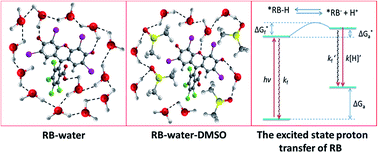Abstract: An excited-state Rose Bengal (RB) nonradiative process caused by proton-induced quenching makes the capacity of photoelectrons to reduce water weak, which crucially influences the efficiency of hydrogen generation for RB-sensitized photocatalytic systems. In this work, we introduced a low content of dimethyl sulfoxide (DMSO) to form a water-DMSO mixture solvent, which significantly inhibited the nonradiative process. The lifetime of the excited electrons was increased remarkably. The hydrogen generation activity in a water-DMSO mixture solvent was 4.48 times higher than that in the single water solvent. The highest apparent quantum efficiency (AQE) of 44.3% was reached at 550 nm. A small amount of DMSO could break the partial network through hydrogen bonding, increase the RB hydrophobicity, and suppress the excited-state RB nonradiative process. KeyWords Plus:VISIBLE-LIGHT IRRADIATION; CHROMOPHORE D-LUCIFERIN; PROTON-TRANSFER; BINARY-MIXTURE; ELECTRON-TRANSFER; CHARGE-TRANSFER; H-2 EVOLUTION; WATER; GRAPHENE; DYE Published in RSC ADVANCES, 6 (35):29538-29544; 10.1039/c6ra01998f 2016
|
